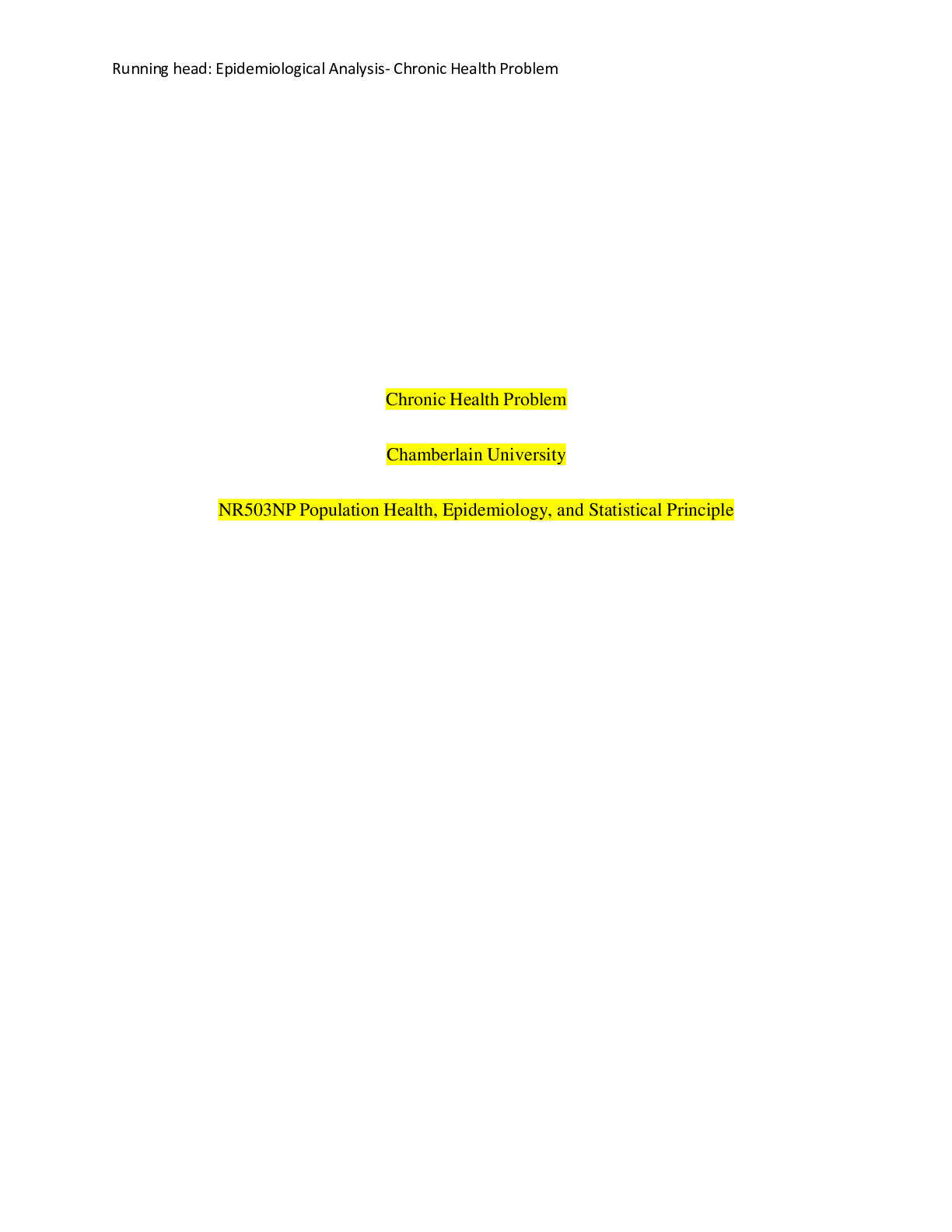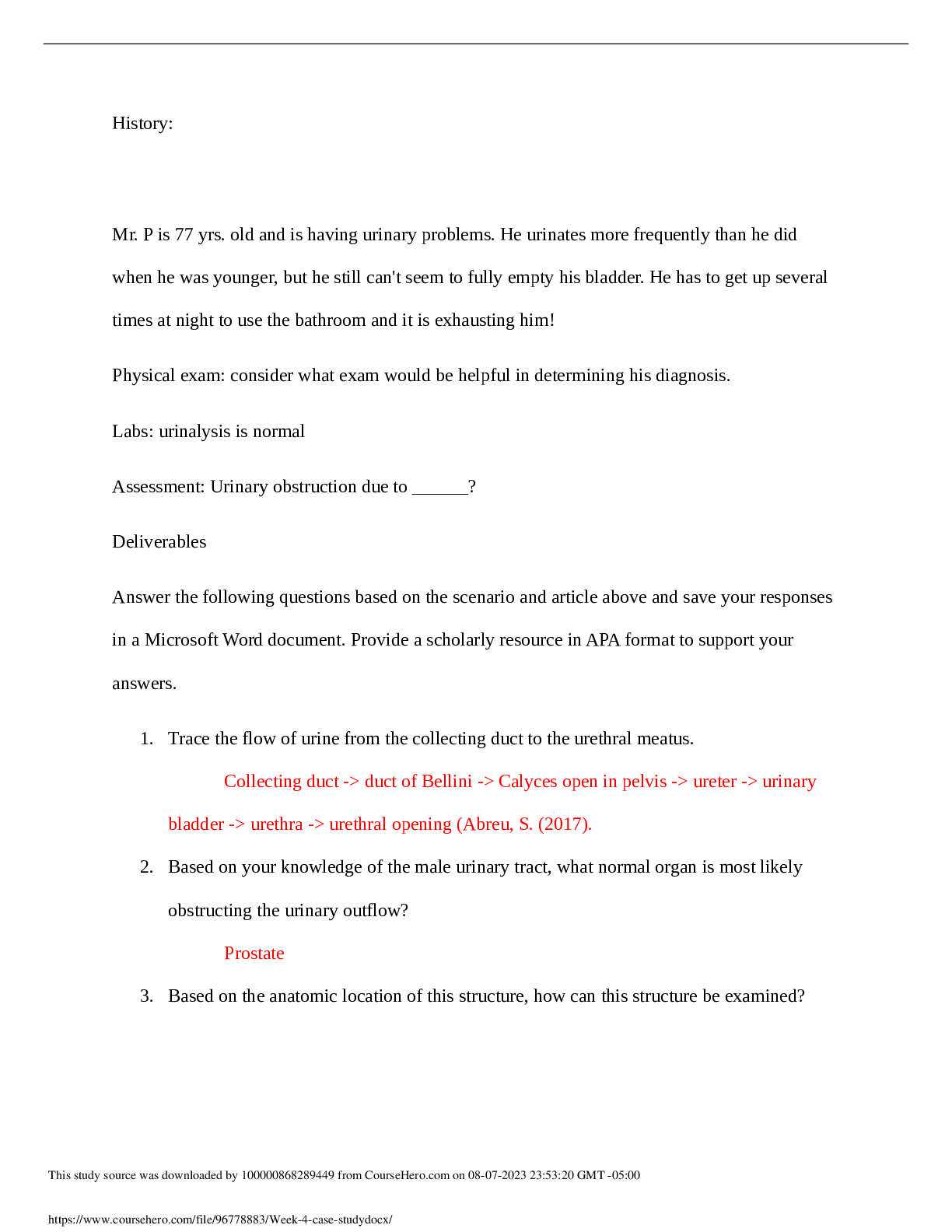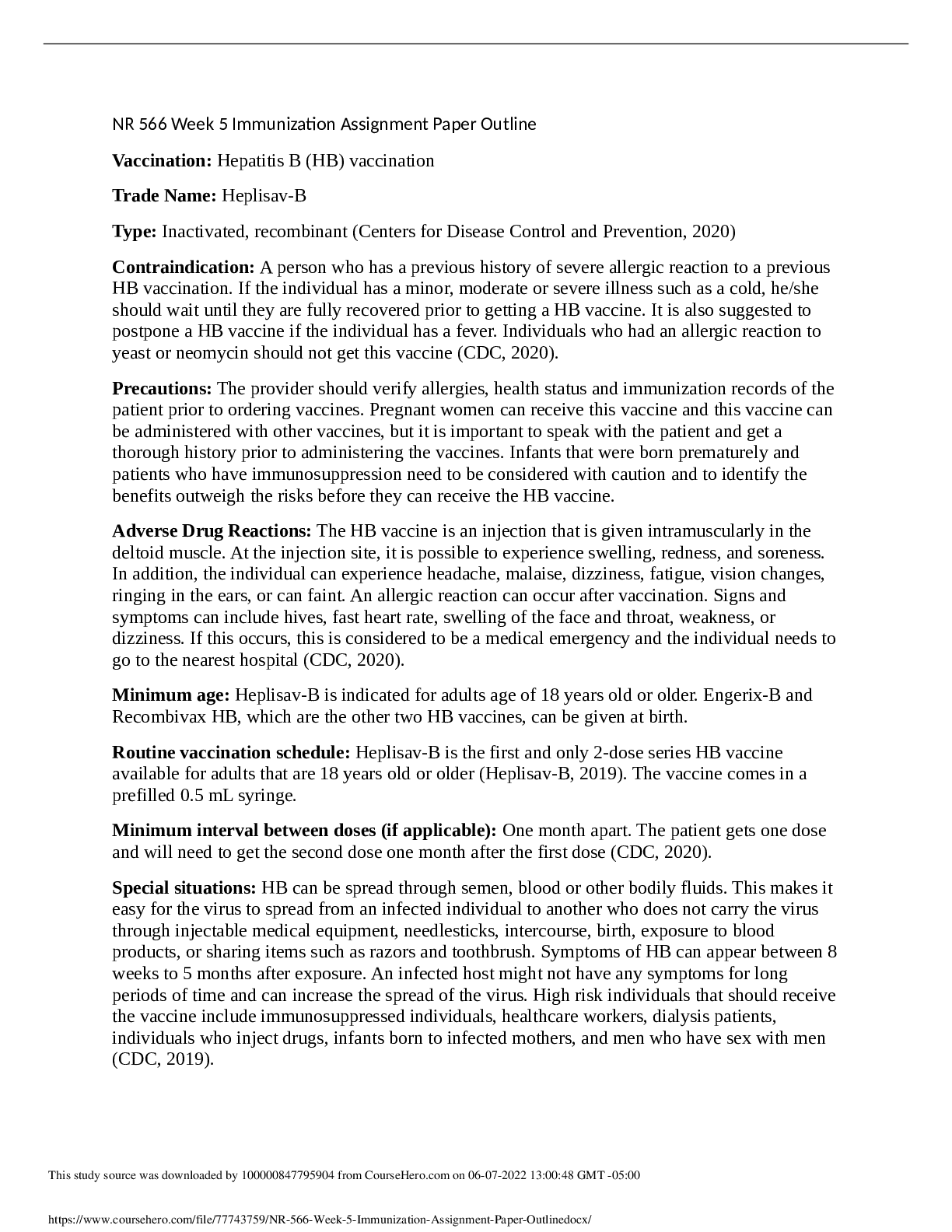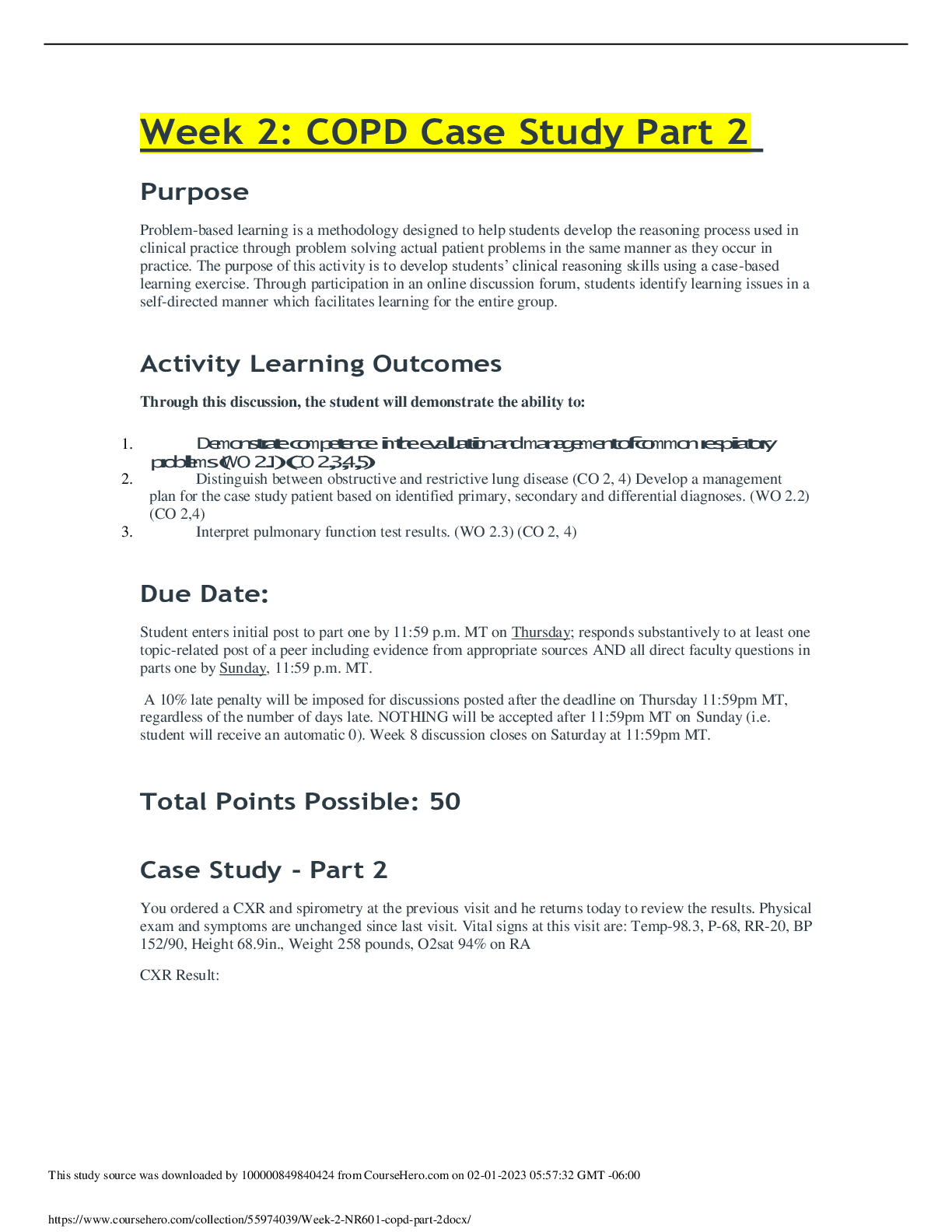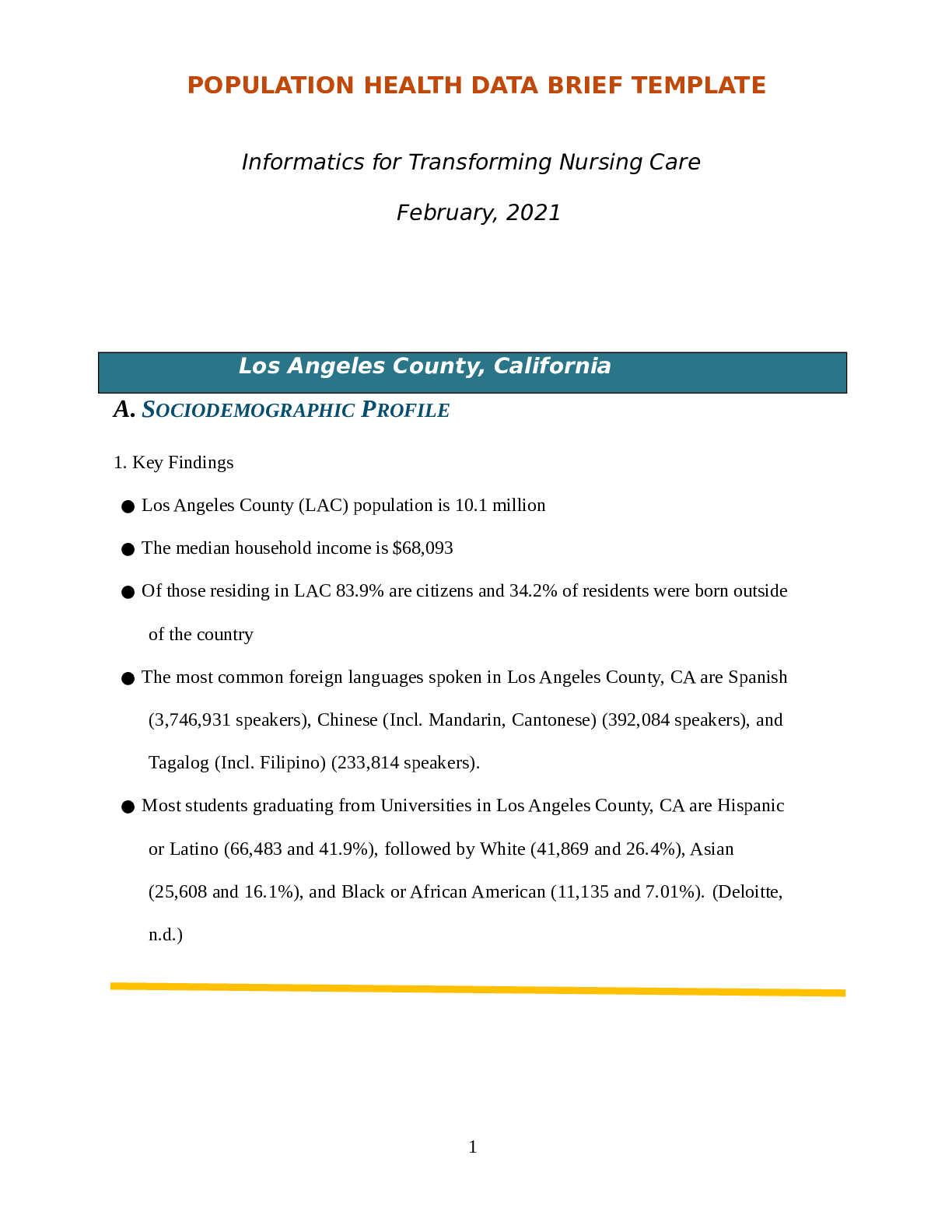*NURSING > CASE STUDY > NR-341 Week 5 RUA Assignment: Interdisciplinary Care Assignment (GRADED A+) (All)
NR-341 Week 5 RUA Assignment: Interdisciplinary Care Assignment (GRADED A+)
Document Content and Description Below
RUA Interdisciplinary Care Chamberlain College of Nursing NR 341: Complex Adult Health Interdisciplinary Care Background Information: Patient’s Name: Byron King Age: 48 Sex: Male Hei... ght: 70 inches Weight: 90.909kg Code Status: Full Code Allergies: Morphine (nausea, vomiting, and hives) Admission date: 03/18/2018 Admitting diagnosis: Lower Gastrointestinal (GI) Bleed Reason for admission: complaints of dark tarry stools for 2 days Occupation or former occupation: Disabled does yard work for extra money Past Medical History: Spinal cord injury (SCI) when he was 22 years old resulting in right side hemiparesis. During hospital stay at that time prescribed morphine for pain control. While taking codeine he developed an allergic reaction displaying nausea, vomiting, and generalized hives. All opioids were stopped and he was given nonsteroidal anti-inflammatory drugs (NSAIDs) as his discharge medication to take at home. Surgical history: None Situation: Mr. Byron King is a 48-year-old African American male brought into the emergency center by his wife. She states that he has been complaining of dizziness and lying around all day which is not his usual activity. His vital signs are temperature 99.1, blood pressure 88/48, heart rate 126, respirations 14, and oxygen saturation 91%. During the nurse’s assessment Mr. King mentions to the nurse that he has been having abdominal pain on a scale of 8/10 that presents 2-3 hours after eating meals and at night time. He said it feels like a stabbing sensation. His abdomen is soft and tender. He stated he has dark tarry stools over the past two days in which his occult stool test came back positive. His hemoglobin blood levels is 7.3g/dL on admission and his skin has a grayish appearance. He stated his daughter’s birthday was coming up and he wanted to buy her something special. Since he is disabled and receives a check his wife depends on that for the bills. In the need of extra money, he has a small lawn cutting business that helps his family financially. Due to the weakness on his right side and old back injury he takes Ibuprofen 600mg daily before going to cut yards. The doctor created a plan for treatment of the patient and wrote orders to facilitate care. The nurse informed the patient of what the plan of care is. The doctor explained to him that he will be having a diagnostic endoscopy done to see the cause of the problem. The nurse obtained the consent and proceeded with care for the patient. She explained to him that he will no longer be allowed to have anything by mouth (NPO) and will be receiving a nasal gastric (NG) tube to help with the abdominal pain. Once admitted to the unit he was placed on NPO status, (NG) tube was placed for low suction, and he was given 2 units of packed red blood cells. The endoscopy report showed ulcers located in the gastric and duodenal mucosa. Laboratory and Diagnostic Tests Diagnostic Test Element Tested Result Normal Range CBC WBC 7.5 µL 4.5-11µL RBC 3.8 mcL (L) 4.7-6.1 mcL Hemoglobin 7.3 g/dL (L) 13.5-17.5 g/dL Hematocrit 34 % (L) 41-49% Platelet 329 µL 150-400 µL Liver Enzymes ALT 28 IU/L 0-35 IU/L AST 26 IU/L 0-35 IU/L ALP 109 IU/L 30-120 IU/L Albumin 4.1 g/dL 3.5-5 g/dL Bilirubin 0.6 mg/dL 0-1 mg/dL Serum Amylase Amylase 250 units/L (H) 30-220 units/L Occult Stool Occult Stool Positive Negative Complete blood count (CBC) is ordered for the patient to determine if there are any differentials of an infection or blood loss disorder. In Mr. King’s case his white blood cell (WBC) count is within a normal range but his red blood cells RBCs are low which indicates some type of bleeding disorder. His hemoglobin levels are also low which are 7.3 and his hematocrit which is 34%. With these three levels being low there is an indication of some type of anemia. “Anemia is a deficiency in the number of RBCs, the quantity or quality of packed RBCs (hemoglobin), and the volume of packed RBCs (hematocrit).” (Lewis, Dirksen, Heitkemper, & Bucher, 2014, p.633). Liver enzymes are checked to see if there is any damage to the liver organ to determine if this is the possible reason for a bleeding disorder. It also helps to ensure that there are no preexisting liver disorders present. One of the functions of the liver is to regulate blood clotting. If the liver enzymes are not within a normal range it signifies that there may be a clotting disorder going on with the liver. Serum amylase tests are checked to see if there is any inflammation in the pancreas causing pancreatitis. If the numbers are high, it’s an indication that there may be an ulcer to the posterior duodenal penetrating to the pancreas. Since his level is 250 units/L and a normal range is 30-220 units/L it means there may be some damage to the pancreas. An occult stool test is used to check to see if there is blood in the gastrointestinal (GI) tract. This test is usually done if a patient reports that he or she has dark tarry stools. Blood in the GI system can be ignored if this is something the patient doesn’t pay attention to. A positive occult test with tarry stools is usually an indication of an upper GI bleed. Further tests are done to find out exactly where the bleed is taking place and what interventions need to be done. An endoscopy is a test used to determine the location and severity of a gastric ulcer located in the stomach and duodenal mucosa of the small intestines. A scope is used to go down the patient’s throat to give a direct visual. During the test samples are collected to check for Helicobacter pylori (H. pylori) infection and to see if the tissue is cancerous. Mr. King’s endoscopy report showed multiple areas of gastric ulcers, but he was negative for H. pylori and cancer. (Lewis et al, 2014). Medications Name Class Therapeutic Use Adverse Effects NSG Implication Rational Ranitidine (Zantac) histamine H 2 antagonists antiulcer agent arrhythmia, agranulocytosis, aplastic anemia *dilute each 50 mg in 20 mL of 0.9% NaCl or D5W for injection *give over 5 min/10mg to promote ulcer healing Omeprazole (Prilosec) proton-pump inhibitors antiulcer agent pseudomembranou s colitis * monitor bowel function. diarrhea, abdominal cramping, fever, and bloody stools * may cause increase in AST, ALT, alkaline phosphatase, & bilirubin to aid in reducing gastric secretions Aluminum hydroxide (alu-tab) antiulcer agents treatment of peptic, duodenal, and gastric ulcer use cautiously in hypercalcemia; hypophosphatemia * tablets must be chewed thoroughly before swallowing followed by full glass of water * monitor serum to increase the gastric pH by neutralizing the hydrochloric acid phosphate and calcium levels periodically during chronic use * For treatment of peptic ulcer may be administered every 1– 2 hr while the patient is awake or diluted with 2– 3 parts water Sucralfate (Carafate) Cytoprotectiv e drug Prevention of gastric mucosal injury anaphylaxis *use cautiously in renal failure and diabetic patients increasing cellular mucosal protection in esophagus, stomach, & duodenal Morphine (astramorph ) opioid analgesics Pain control respiration depression *dilute w/ 5mL of sterile water or normal saline *monitor for orthostatic hypotension *have Narcan readily available to manage moderate to severe Nursing Diagnosis 1. Fluid volume deficient related to active blood loss as evidence by hemoglobin level 7.3 g/dL Nursing outcomes: 1. Patient’s volume returns to normal as evidence by systolic blood pressure ≥ 90 mm HG, absence of orthostasis, urine output greater than 30 mL/ hr, and heart rate 60-100 beats per minute. 2. Patient verbalizes awareness of causative factors and can explain measures to prevent reoccurrence. 3. Patient describes symptoms that indicate the need to consult with health care provider. Nursing intervention: 1. Insert an intravenous catheter to have IV access because parenteral fluid replacement is indicated to prevent or treat hypovolemic complications. 2. Administer blood products as prescribed to correct fluid loss from active gastrointestinal bleed. 3. Administer parenteral fluids as prescribed because fluids are necessary to maintain hydration status. 2. Acute abdominal pain related to increased gastric secretions ae evidence by patient stating stabbing pain on level of 8 out of 10. Nursing outcomes: 1. Patient states pain has decreased to a tolerable level or no pain at all. 2. Patient displays improved well-being such as baseline levels for pulse, BP, respirations, and relaxed muscle tone or body posture. 3. Patient uses pharmacological and nonpharmacological pain-relief strategies. Nursing interventions: 1. Complete thorough pain assessment to get baseline of pain and plan pain management. 2. Foresee the need for pain relief to decrease the total amount of analgesic required. 3. Provide rest periods to promote relief, sleep, and relaxation to create an environment that promotes healing and rest. 3. Ineffective self-health management related to lack of knowledge of long term use of NSAIDs. Nursing outcomes: 1. Patient shows motivation to learn. 2. Patient explains disease state, recognizes need for medications, and understands treatments. 3. Patient demonstrates how to incorporate new health regimen into lifestyle. Nursing intervention: 1. Provide a calm and peaceful environment without interruption to allow the patient to concentrate and focus more completely. 2. Include the patient in creating the teaching plan because this allows the patient to have a sense of control in their care and goals are more achievable. 3. Focus teaching sessions on a single idea and keep sessions short, this allows the patient to be able to focus more on what is being taught at that time. Collaborative Management Emergency room (ER) physician is the person who initially receives the patient and states the diagnosis of the patient. This person orders the lab work and diagnostic studies to provide information on what is going on with the patient. If surgery is needed or an admission to a unit, the ER physician initiates those orders. If it is something that can be taken care of and stopped at this level the ER doctor will prescribe recommended medication and discharge the patient home. The GI doctor is who does a more thorough investigation on the patient’s signs and symptoms and may do the endoscope test to have a better understanding on what is going on with the patient and how to treat him. Based on the results from the diagnostic test he will know what accurate intervention are needed. For example, based on the gastric ulcers size, location, and the amount of blood lost he will know how many units of blood need to be infused. The lab personnel are the people who are involved in running the lab specimens through the correct machines for testing. This may include testing tissue, blood, sputum, urine, or stool. If there is an abnormal reading report the lab personnel are supposed to contact the nurse, so it can be reported to the doctor. The certified nurse assistant or patient care technician assist the registered nurse in helping take care of the patient. They may help with the vital signs and report the abnormal readings to the nurse. Their role is to also help provide nonpharmacological pain relieve such as turning on music or opening curtains to take the patient to a happy place mentally. Their role is to also assist with activities of daily living, recording intake and out put of patients, and help with feeding if it’s not contraindicated. Therapeutic Modalities: The patient received an endoscope test, the purpose of this was to determine if there was a GI bleed and where in the gastrointestinal tract was it located. The nurse role is to obtain a consent for this diagnostic study and make sure the patient understands the test process. The nurse may need to assist the doctor during the procedure. Prior to the procedure the patient’s nothing by mouth status will need to be maintained to prevent aspiration. The nurse responsibility will also include monitoring for return of gag reflex before anything can be given by mouth. The patient will also have a nasogastric (NG) tube inserted to relieve pain and abdominal distention. The nurse’s responsibility will be to monitor the output from the gastric suctioning. While the tube is in place it would be important to assess the patient for comfort and make sure there isn’t skin breakdown in the area of the NG tube placement. Nursing Role Reflection: On admission the patient described the signs and symptoms he was having and assessed by the nurse. Once the nurse reported the assessment findings to the doctor a treatment plan was created. I feel like the doctor and nurse communicated effectively to provide the patient with the care that was needed. The nurse also obtained a signed consent from the patient for the diagnostic studies and explained to him what the plan of care included. In my opinion there was no system barriers created in his care. Based on the symptoms he presented with, his lab work, and diagnostic report he was able to receive care that would lead him in the direction for healing. Due to low hemoglobin levels he was ordered packed red blood cells to raise his fluid volume as a result from the GI bleed. During the patient’s stay starting on admission the nurse can start her discharge teaching with explaining to the patient that long term use of NSAIDs, spicy foods, and stress can trigger the development of gastric ulcers. If he adheres to ways of prevention and taking his medication as ordered he would be able to recovery. I think the care for him ran smoothly from noticing the problem and helping him to identify how he became ill. Evidence based practice shows that early discharge teaching helps the patient gain confidence that they will have support in continuity of care. It also lets them know that their care is centered around them and they aren’t given a generic care plan. References Lewis, S., Dirksen, S., Heitkemper, M., & Bucher, L. (2014). M. Harding (9th ed.), Medical- surgical nursing: assessment and management of clinical problems. St. Louis, MO: Elsvier. McBride, M., & Andrews, G. J. (2013). The Transition from Acute Care to Home: A Review of Issues in Discharge Teaching and a Framework for Better Practice. Canadian Journal Of Cardiovascular Nursing, 23(3), 18-24. Potter, P., Perry, A., Stockert, P., & Hall, A. (2017). W. Ostendorf (9th ed.), Fundamentals of Nursing. St. Louis, MO: Elsvier. Sole, M., Klein, D., & Moseley, M. (2017). Nervous system alterations. (7th ed.), Introduction to critical care nursing. St. Louis, MO: Elsvier. [Show More]
Last updated: 2 years ago
Preview 1 out of 12 pages
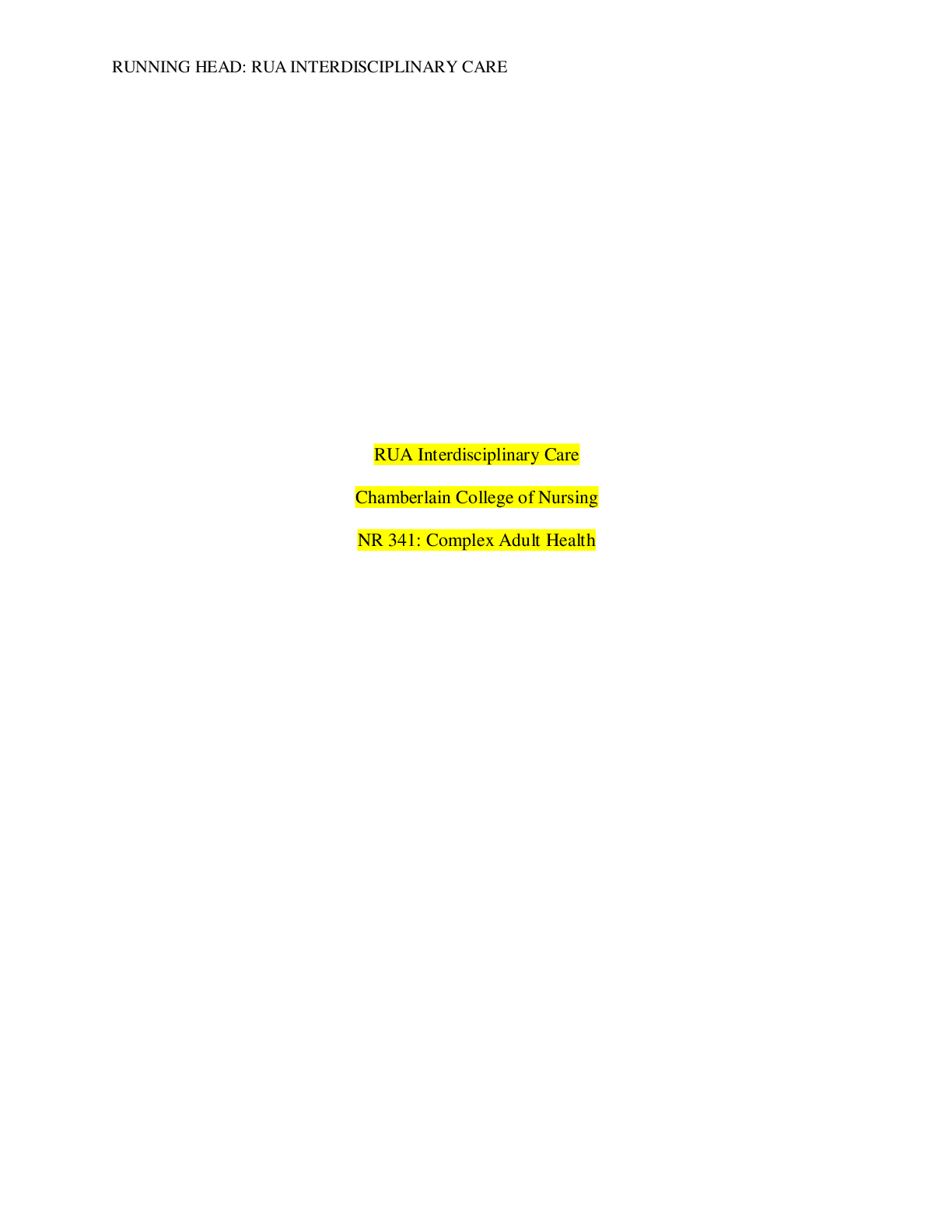
Buy this document to get the full access instantly
Instant Download Access after purchase
Buy NowInstant download
We Accept:

Also available in bundle (1)

NR 341 Complex Adult Health/ NR 341 Course Material Week 1 – 8 BUNDLE | 100% GUARANTEED PASS (REVISED 2021)
NR 341 Complex Adult Health/ NR 341 Course Material Week 1 – 8 BUNDLE | 100% GUARANTEED PASS (REVISED 2021)
By Goodluck Academia 3 years ago
$14.5
10
Reviews( 0 )
$14.50
Can't find what you want? Try our AI powered Search
Document information
Connected school, study & course
About the document
Uploaded On
Sep 08, 2021
Number of pages
12
Written in
Additional information
This document has been written for:
Uploaded
Sep 08, 2021
Downloads
0
Views
121



